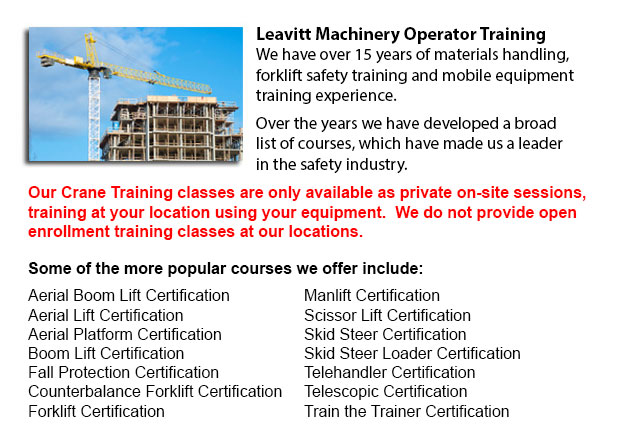
Overhead Crane Operator Training Goodyear - Our overhead crane operator training course is intended to teach workers the fundamentals of overhead crane/sling operation and pre-shift checks. Courses are taught by our expert trainers and consultants. Well-trained staff are more efficient and productive, which really saves on costs connected with merchandise damage, property damage, and accidents because of the use of improper operating procedures. Our overhead crane certification is customized for employees who have literacy barriers, reducing certification time by 50 percent.
Overhead cranes are suitable for specific repetitive hoisting activities. This kind of crane has wide ranging capacities. They may be utilized for specialized lifting tasks such as installing or removing major plant machines.
To safely use an overhead crane, workers must employ safe rigging practices. This needs both practice and knowledge. The load should be rigged correctly to be able to guarantee its stability when hoisted. Prior to beginning a hoisting task, it must be determined that the crane is suitable for the task, with correct travel, lift and capacity. The crane must be subjected to a thorough physical and visual inspection before utilization. The capacity of all machines, including the slings, hardware and rope, must never go over load weight capacities.
Before using the rigger has to know what sling is best for each lift and should check the rigging gear and hardware. The communications that are utilized with the crane operator must be clear and concise. A signaler needs to be chosen for the role and signals need to be agreed upon. The operator of the crane must follow directions just from the chosen individual. If a remote or wired controller is being used, the operator should be trained in all its functions.
To ensure the safety of personnel, a warning must be issued and the path of the load should be cleared of all obstructions before the lift starts. Individuals must not be allowed to walk beneath the lift loads. The crane hoist needs to be centered over the load prior to lifting to prevent swinging. The safety catch must be closed immediately after sliding the sling fully onto the hoisting hook. Unused sling legs should be secured so they do not drag. Never leave loose materials on a load being hoisted. Watch that fingers and hands are clear when slack is taken out of a sling. Before the lift is carried out, step clear of the danger zone.
-
Crane / Overhead Crane / Truck Mounted Crane / Hydraulic Cranes Training in Goodyear
Bridge cranes or likewise called overhead cranes are a kind of industrial material handling crane making use of a line and hook device that runs on a horizontal beam running along two widely separated rails. Many overhead cranes can be seen inside a... More -
Fantuzzi Parts
The Italian Fantuzzi Group offers a glut of material handling equipment and heavy machinery. The equipment consists of numerous equipment specializing in transporting, loading and unloading goods. The railway freight sector and the port authority req... More -
Forklift Training School Goodyear
Forklift Training School Goodyear - Why A Forklift Training School Could Actually Help A Business And Its Employees - CSA and OSHA establish criteria for forklift safety training that meets existing regulations and standards. Anyone intending to oper... More -
Warehouse Forklift Training Classes Goodyear
Warehouse Forklift Training Classes Goodyear - The purpose of warehouse training classes are to raise the awareness of common workplace hazards. The trainees would learn necessary warehouse safety measures. An emphasis is placed on paying attention t... More -
Aerial Lift Ticket Goodyear
Aerial Lift Ticket Goodyear - A boom truck is frequently recognized by the cable and phone business vehicles that have the long arm folded over their roofs. Usually, a bucket-like apparatus sits at the extension of extendable arms. Sometimes termed a... More -
Telehandler Ticket Goodyear
Telehandler Ticket Goodyear - The telescopic handler or telehandler is a generally used equipment in agricultural and industrial applications. This machine is similar in look to a forklift and even works in a similar way, even though telehandlers are... More -
Scissor Lift Safety Training Goodyear
Scissor Lift Safety Training Goodyear - A Scissor Lift is a practical type of platform that normally moves in a vertical direction. The equipment is capable of this movement because of the use of folding supports that are linked in a criss-cross patt... More -
Aerial Boom Lift Training Goodyear
Aerial Boom Lift Training Goodyear - For individuals who operate or supervise the use of aerial lift platforms, right aerial boom lift Training is necessary. The aerial lift platform is for lifting individuals, materials and tools to elevated work lo... More

Forklift Training Goodyear
TOLL FREE: 1-888-254-6157
Goodyear, Arizona
forkliftcertificationgoodyear.com
Email Us
About Us


